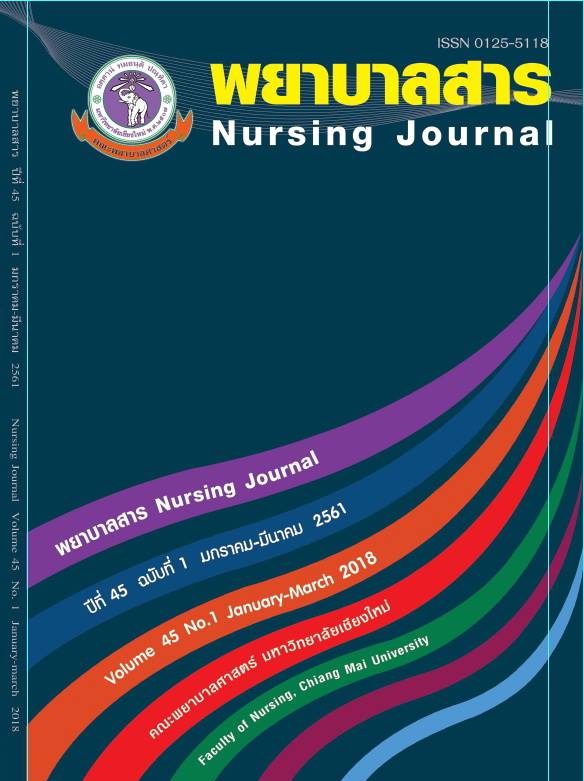Effects of Participatory Learning Regarding Stroke Prevention on Knowledge and Self- Efficacy Among Village Health Volunteers.
Keywords:
Participatory Learning, Stroke, Self- Efficacy, Village Health VolunteersAbstract
Stroke is one of the leading public health problems in Thailand. Primary prevention through Village Health Volunteers (VHVs) is among the most effective ways to decrease the incidence of stroke. VHVs are leaders in community health. This study was a quasi-experimental study and aimed to determine the effects of participatory learning regarding stroke prevention on knowledge and self-efficacy among VHVs. The study participants were selected by purposive sampling. Forty VHVs working at a Primary Care Unit in Tumbon Sarapee, Sarapee district, Chiang Mai province, were enrolled and were randomly divided into 2 groups, each group with 20 participants. The control group received usual advice from hospital or other resources, whereas the experimental group received a participatory learning stroke education program. The study was conducted between December 2014 and January 2015.
The study tools included VHV demographics, the participatory learning stroke education program conducted by the researcher, a stroke knowledge assessment questionnaire and a self-efficacy assessment questionnaire compared before and after use the participatory learning stroke education program. Data were analyzed using descriptive statistics including frequency, percentage, mean, standard deviation, and paired t-test for independent samples.
The results of this study revealed that the experimental group had significantly improved knowledge and higher level of self-efficacy of stroke prevention compared to the beginning of the study and the control group (p = 0.01).
The result of this study showed that the participatory learning stroke education program could improve knowledge and self-efficacy of VHVs. Therefore, the participatory learning stroke education program should be applied among VHVs to improve the efficacy and sustainability of stroke prevention.
References
ฐิติมา อินทร์เนตร, อาภาพร เผ่าวัฒนา และปาหนัน พิชยภิญโญ. (2554). การพัฒนาสมรรถนะแห่งตนร่วมกับการเรียนรู้แบบมีส่วนร่วมของอาสาสมัครสาธารณสุขในการส่งเสริมสุขภาพผู้สูงอายุที่เป็นโรคความดันโลหิตสูง. วารสารสาธารณสุขศาสตร์, 41(1), 5-16.
ทิศนา แขมมณี, (2553). ศาสตร์การสอน:องค์ความรู้เพื่อการจัดกระบวนการเรียนรู้ที่มีประสิทธิภาพ. พิมพ์ครั้งที่ 12. กรุงเทพฯ:สำนักพิมพ์จุฬาลงกรณ์มหาวิทยาลัย.
ธิดารัตน์ อภิญญา และ นิตยา พันธุเวทย์. (2556). ประเด็นสารรณรงค์วันอัมพาตโลก ปี 2556 (งบประมาณปี 2557). (ระบบออนไลน์). แหล่งที่มา http://dpc5.ddc.moph.go.th/SRRTcenter/56-Paralysis.pdf (7 มกราคม 2557)
ประยุทธ แสงสุรินทร์ และคณะ. (2554). คู่มือ อสม. ยุคใหม่. พิมพ์ครั้งที่ 1. กรมสนับสนุนบริการสุขภาพ.
พรรณี ลิ้มสวัสดิ์. (2544). แนวทางการดำเนินงานตามนโยบายรัฐบาลภาคประชาชน เรื่องหลักประกัน สุขภาพถ้วนหน้า(30 บาทรักษาทุกโรค) อาสาสมัครสาธารณสุขรวมพลังยับยั้งยาเสพติด ผลิต ภัณฑ์สุขภาพชุมชน และกองทุนหมู่บ้าน 1 ล้านบาท. นนทบุรี : สำนักงานคณะกรรมการการสาธารณสุขมูลฐาน.
เพชรรัตน์ วิชา.(2556). ประสิทธิผลของการใช้โปรแกรมการเรียนรู้แบบมีส่วนร่วมเรื่องการตรวจเต้านมด้วยตนเองในอาสาสมัครผู้ต้องขังในทัณฑสถานหญิงเชียงใหม่. (วิทยานิพนธ์พยาบาลศาสตรมหาบัณฑิต สาขาวิชาการพยาบาลเวชปฏิบัติชุมชน). บัณฑิตวิทยาลัย, มหาวิทยาลัยเชียงใหม่.
เพ็ญแข แดงสุวรรณ. (2550). Stroke:ฆาตกรเงียบ ระวังภัย ห่างไกล โรคหลอดเลือดสมอง.พิมพ์ครั้งที่ 2. กรุงเทพฯ: สำนักพิมพ์ใกล้หมอ Health & well being.
สมโภชน์ เอี่ยมสุภาษิต. (2553). ทฤษฎีและเทคนิคการปรับพฤติกรรม. (พิมพ์ครั้งที่ 10). กรุงเทพฯ:มหาวิทยาลัยจุฬาลงกรณ์.
อรวดี บวรสิน. (2548). ความพึงพอใจในการปฏิบัตงานของอาสาสมัครสาธารณสุขเขตวังทองหลางกรุงเทพมหานคร. (วิทยานิพนธ์ปริญญารัฐประศาสนศาสตรมหาบัณฑิต). บัณฑิตวิทยาลัย, มหาวิทยาลัยเกษมบัณฑิต.
American Heart Association and American Stroke Association. (2012). Let’s talk about risk factor for stroke , stroke warning sign. (Online). Avilable http://www.strokeassociation.org/idc/groups/stroke-public/@wcm/@hcm/documents/downloadable/ucm_309713.pdf (2 September, 2012)
Bandura, A. (1997). Self-efficacy: The exercise of control. New York: W. H. Freeman .
Burn, N., & Grove, S. K. (2009). The practice of nursing research: Appraisal, synthesis, and generation of evidence(6th ed.). Missouri: Elsevier.
David A Kolb. (1984). Experiential Learning: Experience as the Source of Learning Development. New jersey: Prentice. Hall. Inc.
Polit, D. F., & Hungler, B. P. (1999). Nursing Research Principles and Methods (6thed.).Philadelphia: Lippincott.
World Stroke Organization. (2012). About World Stroke Day. (Online). Avilable http://www.worldstrokecampaign.org/media/Pages/AboutWorldStrokeDay2010.aspx ( 3 July 2012 )
Translated Thai References
Department of Mental Health. (2000). Training Manual about Participatory Learning. (Online). Avilable http://mhtech.dmh.moph.go.th/techno.techno_other/index.html. (7 March 2013)
Thitima Innets, Arpaporn Powwattana and Panan Pichayapinyo. (2011) Self-efficacy enhancement with participatory learning of health volunteer for promoting the health behavior of the elderly with hypertension. Journal of Public Health, 41(1), 5-16.
Tisana Khaemmani, (2010). Science teaching: knowledge in order to provide an effective learning process. (type 12). Bangkok, Thailand: Chulalongkorn University.
Tidarat Apinya and Nitaya Bhuntuwet. (2013). World Stroke Day 2013. (2013 year budget). (online). Avilable http://dpc5.ddc.moph.go.th/SRRTcenter/56-Paralysis.pdf (7 January 2014).
Prayut Sangsurin et al. (2011). Guide line for the new generation of Village Health Volunteers. 1st edition. Department of Health Service Support .
Pannee Limsawat. (2011). Approach to implementation the Government public sector about Universal Health Coverage (The 30 Baht Health Care Scheme), Village Health Volunteers combined drug abstinence , Community Health Products and Village fund 1 million baht. Nonthaburi: Department of Primary Health Care.
Petcharat Wicha.(2013). Effectiveness of implementing participatory learning program of breast self examination among inmate volunteers in Chiangmai woman correctional institution.
Effectiveness of participatory learning program on breast self-examination in inmate volunteers in Chiang Mai Women's Correctional Institution. (Master of Nursing Science Thesis, Community Nursing Practice. Graduate School of Chiang Mai University.
Penkha Dangsuwan. (2007). Stroke: a silent killer, a distant victim of a stroke. 2 Edition . Bangkok: The publisher Klaimor Health & well being.
Sompoch Eeamsupasit. (2010). Theory and techniques in behavior modification. (10 Edition). Bangkok: Chulalongkorn University.
Aonwadee Bawonsin. (2008). Factors Affecting Job satisfaction of Village Health Volunteers in Wangthonglang District, Bangkok. (Master of Public Administration Thesis). Graduate School of Kasem Bundit University.
Downloads
Published
How to Cite
Issue
Section
License
บทความที่ได้รับการตีพิมพ์เป็นลิขสิทธิ์ของวารสารพยาบาลสาร
ข้อความที่ปรากฏในบทความแต่ละเรื่องในวารสารวิชาการเล่มนี้เป็นความคิดเห็นส่วนตัวของผู้เขียนแต่ละท่านไม่เกี่ยวข้องกับมหาวิทยาลัยเชียงใหม่ และคณาจารย์ท่านอื่นๆในมหาวิทยาลัยฯ แต่อย่างใด ความรับผิดชอบองค์ประกอบทั้งหมดของบทความแต่ละเรื่องเป็นของผู้เขียนแต่ละท่าน หากมีความผิดพลาดใด ๆ ผู้เขียนแต่ละท่านจะรับผิดชอบบทความของตนเองแต่ผู้เดียว






